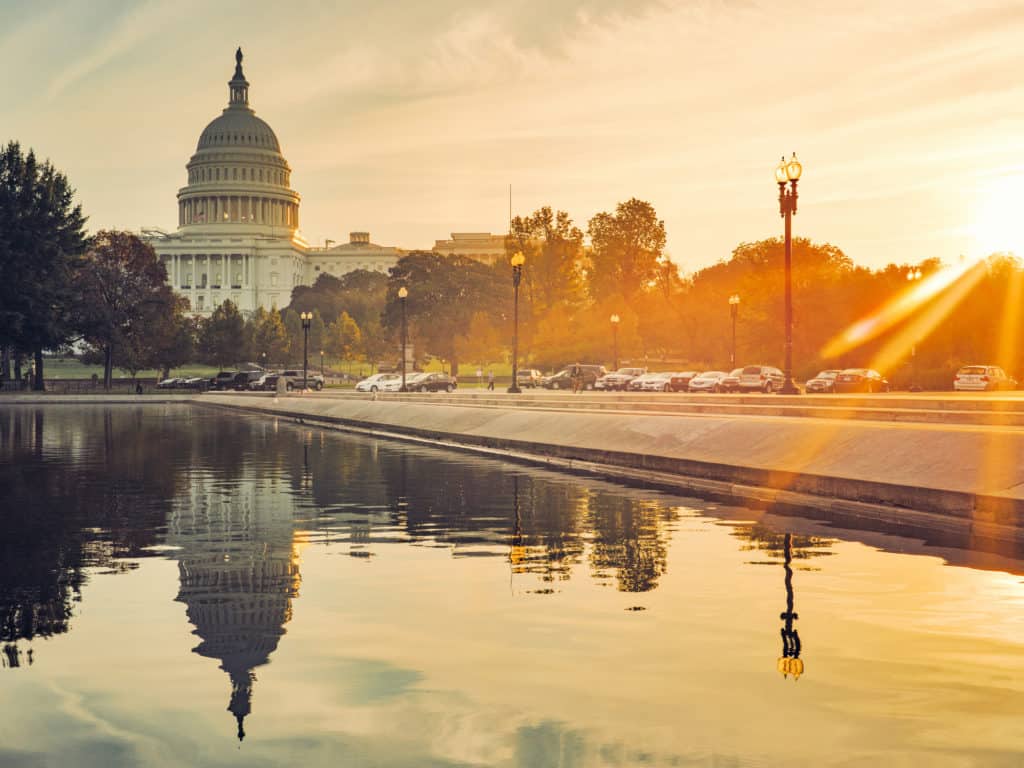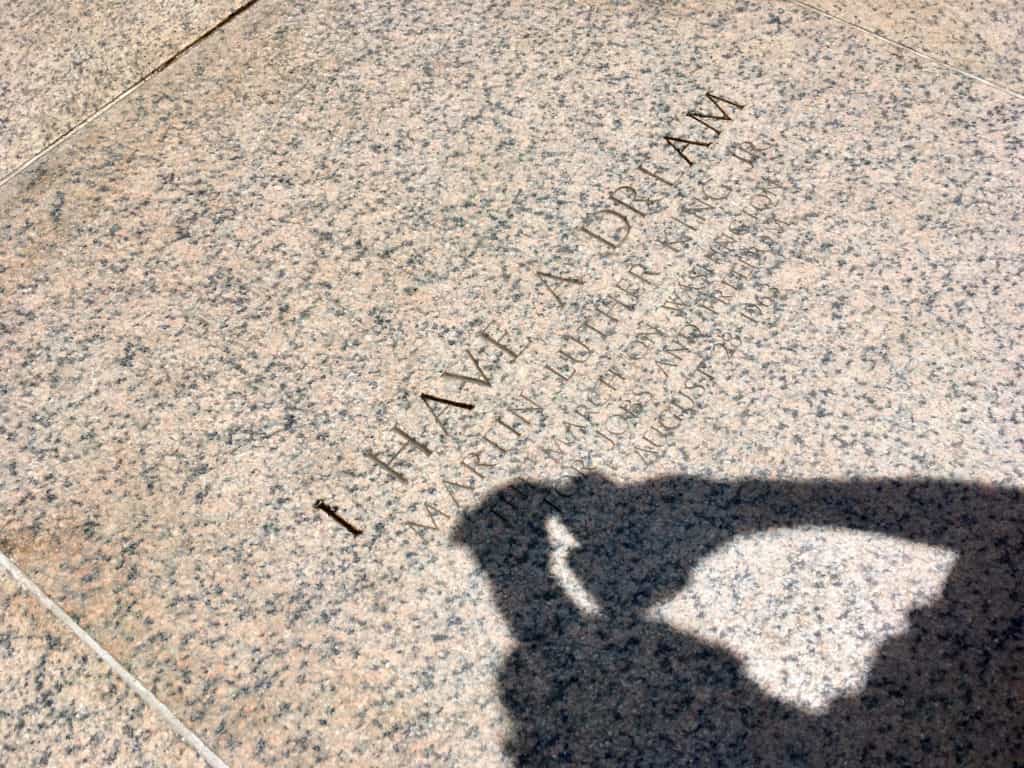With over 200 sites, it can be hard to know where to start on DC’s African American Heritage Trail. The trail details historically and culturally significant sites in Washington, DC, from residences and businesses to churches and schools, all organized by neighborhood. See where Ella Fitzgerald performed, walk in the house Frederick Douglass called home and explore the largest African American museum in the United States.
To launch the process of deepening your understanding of DC’s Black heritage and the community’s vast scope of contribution, read on for some of the trail’s most popular spots as well as local Black-owned businesses.
Top Sites to Visit Along DC’s African American Heritage Trail
Stops in Greater U Street Neighborhood
This neighborhood gained a reputation as “Black Broadway” because of the many musicians and performers that lived and created here. While Harlem in New York City stands out in many people’s minds as a historical epicenter of Black art and culture, the U Street neighborhood of DC actually predates it as an influential creative hotbed. But the neighborhood doesn’t just stand out for its luminous history — after a decade of revitalization efforts, U Street is a must-visit for its contemporary offerings – it’s one of the most vibrant areas of DC.

Lincoln Theatre (1215 U Street, NW)
Opened in 1922 as an elegant first-run movie house, the Lincoln Theatre also included The Lincoln Colonnade, a public hall where events such as band performances and social club balls took place. After legal segregation ended in 1953, audiences shifted their attention to other spots in the city and, over time, both the Colonnade and the Theater closed. However, restoration efforts brought Lincoln Theatre back in 1994 and today it is a thriving performing arts center. Check out the Lincoln Theatre performance schedule here.
African American Civil War Memorial and Museum (1925 Vermont Avenue, NW)
The evocative The Spirit of Freedom sculpture and adjacent Wall of Honor inscribed with servicemen names commemorate 209,145 African-American soldiers and sailors who served in the U.S. Army and Navy during the Civil War. The efforts of the U.S. Colored Troops (USCT) brought the end of the war closer and helped free over four million slaves. Exhibits in the adjacent museum tell the story and convey the broader military history of the Black community.
The Howard Theatre (620 T Street, NW)
In 1910, two decades before the legendary Apollo Theater in Harlem launched its famed “Amateur Night,” the Howard Theatre opened its doors for premieres of live music performances, plays, vaudeville shows, films and talent contests. People flocked to see the likes of native Washingtonians Duke Ellington and Mary Jefferson perform here along with Ella Fitzgerald, Jackie ‘Moms’ Mabley and Motown’s top acts, from Marvin Gaye to Aretha Franklin. After serving as the influential bedrock of R&B, pop, rock, hip hop and more through its jazz and blues performances, the theater closed in 1970 and experienced a bumpy road of openings and closings until 2012, when it was restored and began hosting headliners across various genres. Quincy Jones has called the stage at the Howard Theatre “the setting for some of the greatest performances by the greatest performers of the 20th century.”
Drinking & Dining Tip: While you’re in the U Street neighborhood, sample the signature Half Smoke (a DC version of a hotdog) at the iconic Ben’s Chili Bowl (1213 U Street NW) and celebrate its role in DC’s Black history, culture and character. Founded 61 years ago by Virginia Ali, 85, and her husband Ben, Ben’s has endured many travails, from the 1968 race riots to the downturns of the 70’s and 80’s. Another great place to eat is Dukem Ethiopian Restaurant (1114-1118 U Street), selected multiple times as the best Ethiopian restaurant by Washington City Paper Readers Poll.
If you’re looking to grab a cold one, order beer through Biermi from local Black-owned breweries Sankofa Beer Company and Soul Mega.
Stops in Logan Circle Neighborhood
Lined with grand Victorian homes that lured writers and artists in the 1920s, Logan Circle inspired such African American luminaries as artist Alma Thomas and civil rights leader Mary McLeod Bethune.
Mary McLeod Bethune Council House (1318 Vermont Avenue, NW)
Once the home of educator and civil rights leader Mary McLeod Bethune (1875-1955), this three-story structure became the first headquarters of the National Council of Negro Women (NCNW), which was founded by Bethune in 1935. She also served as its first president and as a vital advisor to four U.S. presidents. Today, the house is a museum with exhibits that interpret Bethune’s life and Black women’s history.
Alma Thomas Residence (1530 15th Street, NW)
This house was the family residence of acclaimed artist Alma Thomas (1891-1978). Thomas was the first Fine Arts Department graduate of Howard University and taught art in a local junior high school for 36 years while making art in her home’s kitchen, which doubled as her studio. An artistic iconoclast, she veered from the social realism of her contemporaries, taking a more abstract approach to color and composition. The masterful work of this major Washington Color Field School painter can be found in top museums around the country. While you can’t go inside the residence, you can see Alma’s artwork at the Smithsonian American Art Museum and the National Museum of Women in the Arts.
Stops in the National Mall
The National Mall historic district is also called “America’s Front Yard” because it is home to many of the U.S.’s most iconic and cherished monuments and memorials. You’ll find some of the most prominent and inspirational monuments to Black history and culture on and near this long, grassy stretch, anchored by the soaring Washington Monument, the Lincoln Memorial Reflecting Pool, the Lincoln Memorial, the U.S. Capitol Building and various Smithsonian museums.

Martin Luther King, Jr. Memorial (1850 West Basin Drive, SW)
Covering four acres, the Martin Luther King, Jr. Memorial is anchored by the “Stone of Hope” sculpture. The sculpture is surrounded by 17 remarkable MLK quotations inscribed in granite and the 30-foot memorial expresses Dr. King’s extraordinary role as a leader of the American Civil Rights Movement. Depicting Dr. King rising from a pair of large boulders known as the Mountain of Despair, the memorial was the first to honor a Black individual on the National Mall. In 1963, Dr. King led the March on Washington to advocate for civil and economic rights and issued the now-legendary “I Have a Dream” speech on the steps of the Lincoln Memorial. Stand by the Reflecting Pool to contemplate his extraordinary message.
To further your experience of DC-based tributes to Dr. King, visit the recently modernized Martin Luther King Jr. Library (901 G St. NW), which serves as DC’s central library and showcases the leader’s life and legacy.
The Smithsonian National Museum of African American History and Culture (1400 Constitution Ave. NW)
If you only have time to visit one location on this list, head to the eight-story Smithsonian National Museum of African American History and Culture. Opened in 2016, it is the only national museum dedicated exclusively to the documentation of Black life, history and culture. Browse its more than 36,000 artifacts that extend from the time of the African Diaspora to today. And while you’re there, grab a bite at the Sweet Home Café, which explores the story of Black culinary culture in four stations that capture the food traditions of distinct regions. Try oyster pan roast, gumbo or buttermilk chicken among other culturally significant (and delicious) offerings.
Though not a part of the African American Heritage Trail, the Greensboro Lunch Counter featured at the nearby Smithsonian National Museum of American History (Constitution Avenue, NW between 12th and 14th Streets) is one of the most significant artifacts of the Civil Rights Movement. Four African American college students sat down at the counter in a North Carolina-based Woolworth’s on Feb. 1, 1960 and refused to leave when asked. The students’ insistence on staying in their seats sparked a forceful youth-led movement that challenged inequality in the American South, ultimately leading to the desegregation of the F.W. Woolworth lunch counter on July 25, 1960 and, together with many other such protests, to the passage of the Civil Rights Act of 1964.
Stops in the Anacostia Neighborhood
Anacostia (also known as Uniontown) is one of DC’s oldest neighborhoods. Renowned orator and statesman Frederick Douglass was one of the historic figures who lived in this storied neighborhood.
Frederick Douglass National Historic Site (Cedar Hill) (14th and W Streets, SE)
This is the former home of Frederick Douglass (c. 1818-1895), renowned abolitionist, writer and statesman. Get a glimpse into Frederick’s life with a guided tour of his house, which was restored to its 1895 appearance and includes objects that belonged to him. Eight acres of Frederick’s original estate are protected by the park and make for a great place to picnic, get some fresh air or simply relax.
Known as the “Sage of Anacostia,” Frederick Douglass held many important roles while residing in the home, among them President of the Freedman’s Bank, U.S. Marshal for the District of Columbia and minister to Haiti. He also advised President Lincoln during the Civil War, urging him to live up to the stirring ‘all-men-are-created-equal’ concepts expressed in the Declaration of Independence.
The Anacostia Community Museum, Smithsonian Institution (1901 Fort Pace, SE)
Established in 1967, the Anacostia Community Museum, strives to examine shifting concepts of community while staying firmly rooted in the neighborhood, and presents exhibits and programs focusing on African American culture. The museum houses a collection of approximately 6,000 objects dating back to the early 1800s.
Beyond the Trail
These stops aren’t on DC’s African American Heritage Trail but will immerse you in the legacy of some of the nation’s greatest Black musicians, activists and DC’s local community.
African American Musical Legends
DC has served as a launch pad for some of the U.S.’s greatest African American musical talents, from jazz great Duke Ellington to R&B legend Marvin Gaye to go-go music visionary Chuck Brown (the mayor of DC signed a measure making go-go the official music of the nation’s capital in early 2020). You can still catch Brown’s go-go music at music venues throughout DC, pay homage to him at the Chuck Brown Memorial Park in Northeast DC (20th & Franklin St. NE) and shop for his music and others’ at one of the city’s cool record shops, like HR Records. To honor Marvin Gaye’s legacy, see the Marvin Gaye mural by artist Aniekan Udofia in the Shaw neighborhood (710 S St. NW), visit the stream in Marvin Gaye Park (at 1.6 miles, the longest municipal park in DC) where the musical giant used to sit and compose, and enjoy a meal at Restaurant Marvin on 14th Street.
Visit Black Lives Matter Plaza and Shop Black-Owned Businesses
Don’t leave DC without seeing the bold new street mural in Black Lives Matter Plaza, the two-block-long pedestrian section of 16th Street NW, given its name by Mayor Muriel Bowser on June 5, 2020 after the Department of Public Works painted the words “Black Lives Matter” in large yellow capital letters on the street surface.
For mementos of your trip, browse the gift shops at the museums mentioned above as well as DC’s black-owned retail businesses and brands.
